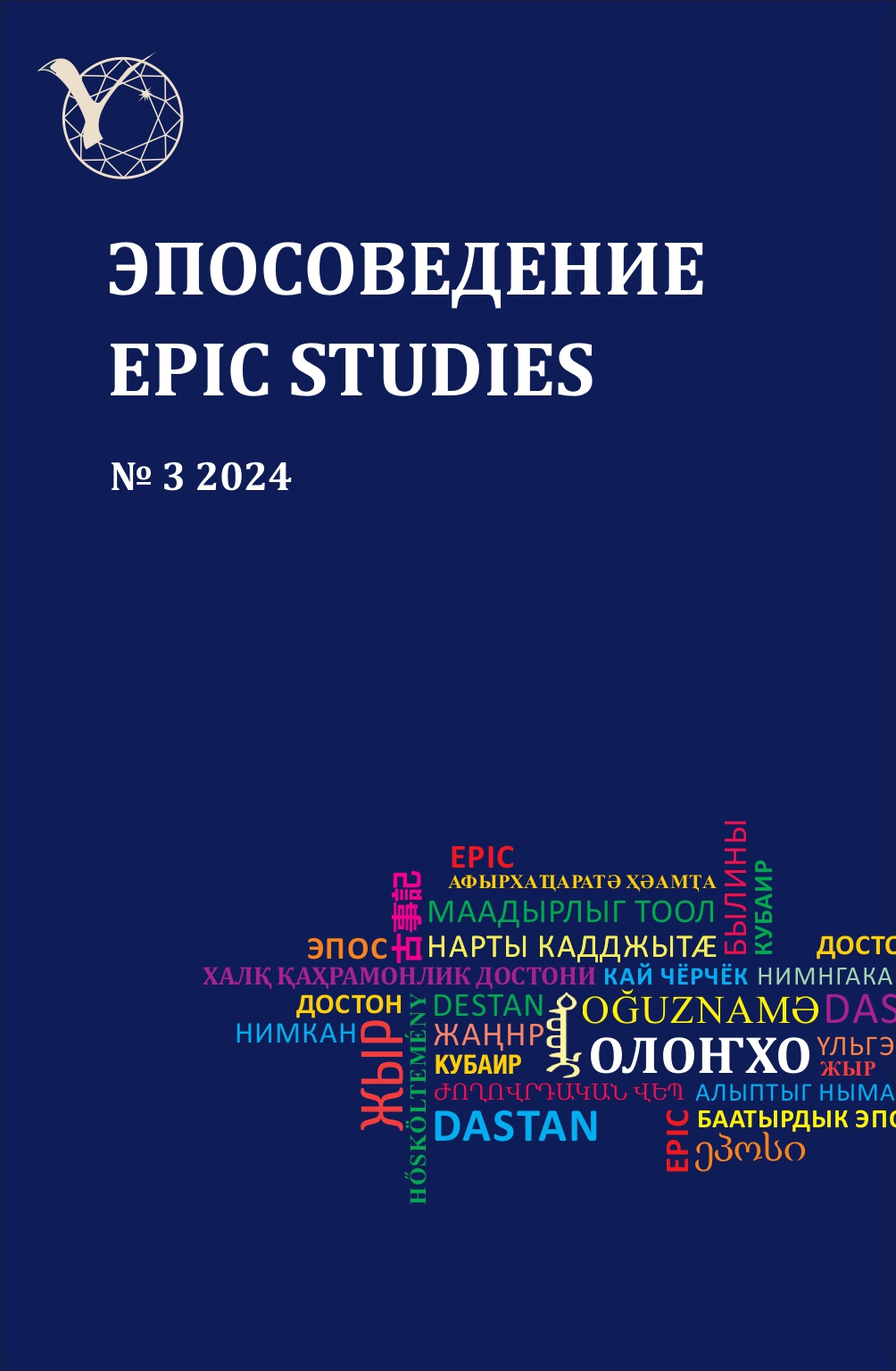Ways of expressing comparison in the folklore of the Barabians (based on the materials of V. V. Radlov and L. V. Dmitrieva)
DOI:
https://doi.org/10.25587/2782-4861-2024-3-85-96Keywords:
Baraba Tatars, folklore, comparison, dastans, heroic tales, oral folklore traditions, comparatives, minority ethnic groups, indigenous Turkic peoples of Siberia, endangered languagesAbstract
The language of the Baraba Tatars, an indigenous small Turkic-speaking ethnic group living in the Novosibirsk Region, is considered to be severely endangered. Its levels are extremely poorly understood. The purpose of this article is to study the ways of expressing comparativity based on the material of this idiom and such study is being conducted for the first time. To achieve this goal, folklore texts presented mainly by dastans, i. e. heroic tales, published in two works: V. V. Radlova “Samples of folk literature of Turkic tribes living in Southern Siberia and the Dzungarian steppe” and L. V. Dmitrieva “The language of the Baraba Tatars” were analyzed. An approach developed in the Sector of Languages of the Peoples of Siberia at the Institute of Philology of the Siberian Branch of the Russian Academy of Sciences was used to analyze the linguistic material. In the course of the study, the following ways of transmitting comparativity were identified: 1) the equivalence is expressed by affixes =taw / =täw; =lai / =läi and =layin / =läyin; predicates of similarity osha= ʻto be similarʼ, oqsha= ʻto be similarʼ; analytical index bolyp; parametric name sorlugu ʻthe same size asʼ; and other means – words shägällü ʻsimilarʼ, käbäk ʻsimilar, alikeʼ, tagynnajyn ʻthe same wayʼ; 2) differentiation of the compared objects is achieved both by lexical means – the words artyk ʻbetter, best ʼ, eng ʻthe mostʼ, otary ʻmore and more ʼ, kichӓ, kichyӓ ʻlessʼ, and with the help of the affix of comparison =rak / =rӓk. In most cases, the parameter and/or comparison standard is expressed implicitly and is deduced from the context. Examples from each group are represented by an uneven number of units. On the one hand, this may indicate a different frequency of use of certain ways of expressing comparison, on the other hand, genre features may have imposed restrictions on usage. In general, the considered comparisons have analogues in other Turkic languages, but also have a certain uniqueness, which can be accounted for by the transitional nature of the language of the Baraba Tatars – from the South Siberian Turkic languages to the languages of the Urals and the Volga region, as well as Central Asia. In the future, it is planned to consider the use of comparative concepts based on the material of the colloquial speech of the Barabians.
References
1. Radlov, V. V. Samples of folk literature of the Turkic tribes living in Southern Siberia and the Dzungarian steppe, collected by V. V. Radlov = Proben der Volksliteratur der turkischen Stamme Sud-Sibiriens: [in the original languages]: [in 10 books]. Saint Petersburg, Printing House of the Imperial Academy of Sciences, 1866–1907. (The dialects of the Turkic tribes living in Southern Siberia and the Dzungarian steppe. I section, Samples of folk literature). Part 4: Dialects of the Baraba, Tarsk, Tobolsk and Tyumen Tatars. 1872. XV, 411 p. (In Rus.)
2. Dmitrieva, L. V. The language of the Baraba Tatars. Leningrad, Nauka Publ., 1981, 225 p. (In Rus.)
3. Yusupov F. Yu. V. V. Radlov and his book “Samples of folk literature of Turkic tribes living in Southern Siberia and the Dzungarian steppe. Part 4. The dialects of the Barabin, Tarsk, Tobolsk and Tyumen Tatars” (St. Petersburg, 1872) [Text]: [in Russian and Tatar]. Nizhny Tagil : Online service, 2021, 911 p. (In Siberian Tatar and Rus.)
4. Mukhametzyanova, L. Kh. The epic culture of the Tatars. Dustans. Kazan, G. Ibragimov Institute of Language, Literature and Art of the Academy of Sciences of the Republic of Tatarstan, 2023, 120 p. (Customs and traditions of the Tatar people). (In Rus.)
5. Urmanche, F. I. The Turkic heroic epic. Kazan, G. Ibragimov Institute of Language, Literature and Art, 2015, 448 p. (In Rus.)
6. Meletinsky, E. M. The origin of the heroic epic: Early forms and archaic monuments. 2nd ed., corrected. Moscow, Oriental Literature Publ., 2004, 462 p. (Studies on folklore and mythology of the East: Founded in 1969) (In Rus.)
7. Koshkareva, N. B., Plotnikov, I. M. Metalanguage of the description of the semantics of comparison as a linguistic sign. Kritika i semiotika, 2023, No. 2, pp. 180–216. (In Rus.)
8. Tumasheva, D. G. Dialects of the Siberian Tatars. The experience of comparative research. Kazan, Kazan University Press, 1977, 296 p. (In Rus.)
9. Andersen, H. C. Fairy tales and stories. In 2 vols. Vol. 1. Leningrad, Khudozhestvennaya loiteratura Publ., 1969, 584 p. (In Rus.)
10. Ozonova, A. A. Ways of expressing comparison in the Altai epic (based on the material of the epic “Ochy-Bala”). Epic studies, 2023, No. 3, pp. 42–55. DOI: 10.25587/2782-4861-2023-3-42-55. (In Rus.)
11. Tybykova, A. T., Cheremisina, M. I., Tybykova, L. N. Syntax of a complicated sentence in the Altai language. 2nd ed. Gorno-Altaisk, Gorno-Altaisk State University Press, 2013, 268 p. (In Rus.)
12. A Tatar-Russian dictionary: in 2 vol. (A–L). Kazan, Magarif Publ., 726 p. (In Tatar and Rus.)
13. Wheeler, B. M. Prophets in the Quran: An Introduction to the Quran and Muslim Exegesis. London; NewYork, Continuum Publ., 2002, 404 р.
Downloads
Published
How to Cite
Issue
Section
License
Copyright (c) 2024 EPIC STUDIES

This work is licensed under a Creative Commons Attribution 4.0 International License.
Copyright (c) 2021 Copyright (c) This work is licensed under a Creative Commons Attribution 4.0 International License.












 Olonkho Research Institute, M.K. Ammosov North-Eastern Federal University
Olonkho Research Institute, M.K. Ammosov North-Eastern Federal University